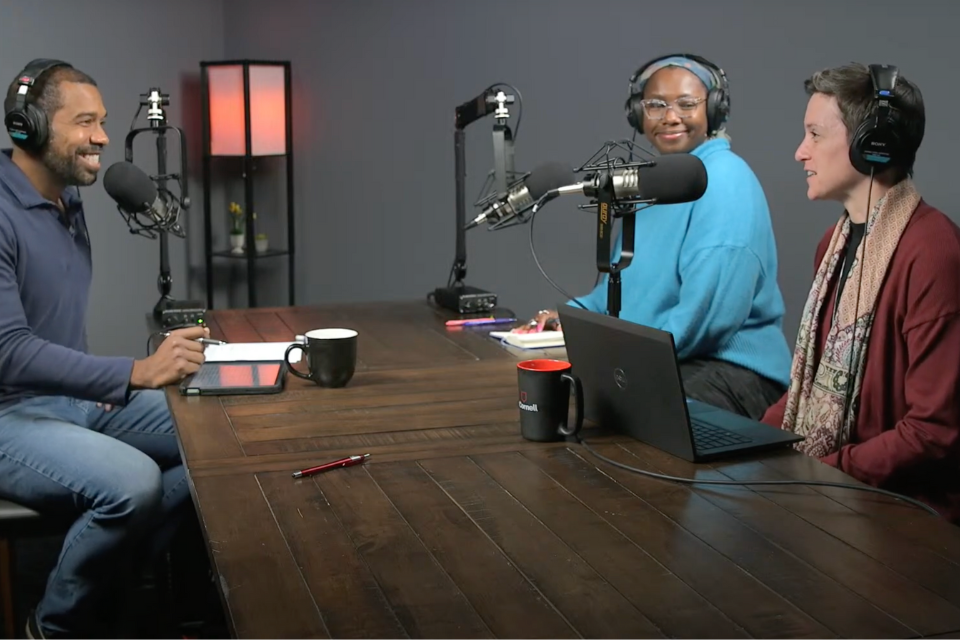The power of focused listening in conflict resolution

According to The Myers-Briggs Company, managers spend at least four hours managing conflicts per week on average, with poor communication being the biggest cause of conflict. Yet, at the forefront of effective conflict resolution lies a frequently overlooked fundamental skill: focused listening.
In the Cornell Keynote webcast “Focused Listening: From Conflict to Collaboration,” Katrina Nobles, director of conflict programs, and Liz Davis-Frost, mediation and training extension associate, both from the Cornell University Scheinman Institute on Conflict Resolution, discuss how focused listening promotes interpersonal understanding and collaborative problem-solving.
What is focused listening?
Nobles: “Focused listening, sometimes called ‘deep listening,’ is a tool that comes from the transformative mediation model. It relies on being present and listening to listen — not to respond, craft an opinion or solve a problem. This approach requires us to suspend our judgments and try to truly understand what the other person is saying.”
How can practicing focused listening contribute to effective team dynamics, particularly in supporting less assertive members?
Nobles: “First and foremost, I recommend reflection — reflecting back to the person what you heard — because it prompts you to pay attention to what the other person said without jumping to respond or diminish their words. Pairing focused listening with reflection gives the other person space to correct any misunderstandings.
Secondly, one thing that is largely missing in U.S.-based workplaces is the consideration of nonverbal communication styles. Deep listening works with written communication, like anonymous feedback forms, which are particularly helpful in situations with power imbalances. For instance, a new employee might be less assertive because they are still navigating when it is appropriate to speak up and share their opinion.”
Davis-Frost: “Some of us didn’t grow up in cultures or communities where sharing thoughts, unless explicitly asked, was encouraged. It’s important to recognize that assertiveness, or lack thereof, isn’t due to singular reasons but is shaped by a lifetime of circumstances and experiences.
Everyone in the room has a unique life journey leading to this moment. Sometimes, those more attuned to these nuances try to share with those less aware, but this can feel awkward or become therapeutic, so it’s essential to navigate these dynamics with care.”
Why is conflict a good thing, especially when trying to solve a problem or finish a project?
Davis-Frost: “If I go into every conflict thinking it’s a bad thing, that will influence how I navigate it and my results. Going into conflicts knowing they are inevitable allows me to approach them with curiosity and think about how the situation can help me learn and grow. We put a lot of pressure on ourselves to not make mistakes, which is unrealistic. We need to build a capacity for grace and understanding and patience while being able to hold each other accountable.”
Nobles: “Conflict is often perceived as a negative thing. Eradicating conflict altogether isn’t helpful because it limits the variation of perspectives and ideas within a group. Conflict can be destructive, but it can also be constructive, and we need to mentally reframe it as a powerful tool for problem-solving. When a conflict arises in the workplace, we have to figure out how to approach it in a way that respects team members’ differing perspectives and incorporates them into creative solutions.”
How can teams implement focused listening to help problem-solve together?
Nobles: “One way to use deep listening in team meetings is to combine it with reflection. If you make an agreement with your team that you’re going to reflect back what you just heard before countering it or adding another idea, you can allow for enough of a pause to consider how you plan to contribute to the conversation without escalating beyond the point of control. Another way to use deep listening is in brainstorming. When we’re brainstorming, we’re often throwing out ideas so quickly that we may either miss an idea or the point of an idea. Again, implementing focused listening gives just enough of a pause to reflect on what was said to ensure you understand the idea so you can clarify your own thinking before sharing even more options.”
Davis-Frost: “Sometimes, in brainstorming, ideas are presented with no points. If team members are asking clarifying questions, it’s an indicator that people are having a hard time understanding the point and that I need to think a little further and develop that idea, which the team can support me in doing.”
What first step should managers take when introducing focused listening to their team?
Davis-Frost: “Beyond this Keynote and our prior webcast, I recommend spending time practicing and working through deep listening skills yourself before bringing them to the workplace. We see a lot of people try to implement these tools without fully developing them, which is contributing to conflicts because people have questions about what deep listening is.”
Nobles: “I would definitely try deep listening out for yourself as a first step so that you can speak to it genuinely. Second, I would have a conversation about it with your team where you highlight wanting to create an environment where team members can hear each other better and be more creative together. Offer for the team to try it out in a meeting and see what happens.”
Davis-Frost: “Adding to that, don’t hesitate to reach out for support if you need it. There are lots of practitioners out there who are supporting people and having transformative conversations, so don’t put all the pressure on yourself to do a dissertation’s worth of research on focused listening in a couple of nights and then present it to your staff.”
How can one adjust their deep listening approach when they don’t have much in common with someone and still be genuine?
Nobles: “Keeping in mind that we have more connections than we think we might, deep listening can be more impactful with the people you don’t have much in common with because you are genuinely trying to understand where they’re coming from. If you come to a conversation with genuine curiosity, it can make a really powerful connection of being open and providing space to another person.”
To learn more about focused listening as a tool for conflict management, watch part one of this conversation, “Listen Closely: Gaining Clarity During Conflict,” on the eCornell website and explore Cornell’s Conflict Resolution certificate program authored by Katrina Nobles.
This Q&A, drafted by former eCornell writing intern Margot Baker, has been edited for length and clarity. Experience the full Keynote “Focused Listening: From Conflict to Collaboration” on the eCornell website.








